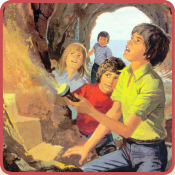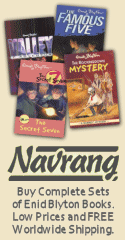
The Wheel That Ran Away

Book Details...
First edition: 1967
Publisher: Brockhampton Press
Illustrator: Jacques Fromont
Category: John and Mary
Genre: Family
Type: Short Story Books
Publisher: Brockhampton Press
Illustrator: Jacques Fromont
Category: John and Mary
Genre: Family
Type: Short Story Books
On This Page...
If you forget only the tiny things, it doesn't really matter at all? That's John's philosophy. Big things may be looked upon a little differently but leaving his new spade out in the rain is considered of minute concern. His Daddy's philosophy however holds that little things can turn into a big things so John is scolded for his carelessness.
The scene shifts and we see a picture of the boy looking proudly at his cart. He actually made it himself from a wooden box purchased at the grocer's for sixpence, some wheels he got from the gardener, and a handle has been attached to the box for hauling it along. His father thinks it'll be very useful item and he's right because John can give Mary a ride all round the garden for a treat, and he also takes his cart each day when shopping for mother. It carries all kinds of things, even heavy articles like potatoes but after a few weeks of such intensive use, the cart develops a fault and Daddy points it out.
"John, that wheel will soon be off. It needs a new nail knocked in."
Then a picture is seen of John wearing his red Indian feathers and carrying a bow with some arrows which means, of course a slight delay in the proceedings, but don't fret ... he'll fix the cart tomorrow . One can but guess what the near future might bring when father's prognostication is recalled.
Next day, Mummy requires six pounds of carrots and what better way to get them than enlisting her son with his cart. John looks at the wobbly wheel and decides, as we all do, that one more trip isn't likely to bring any woe, so he sets off to the greengrocer's and we see an image of the proprietor, hands on hips, looking at John's loaded cart as the boy sets off for home. The next picture shows John looking very distraught as he watches a cart wheel rolling away down the hill all by itself.
His Dad's very words were, "You never know when a little thing will turn into a big thing" and how true they were. Yes, one little thing such as a runaway wheel can lead to another and the result of this particular incident can only be described as 'Calamity' (with a capital C). An illustration at the end shows John kneeling on the floor with a money box, a hammer, and a collection of coins. The cash won't be going back into his piggy bank unfortunately.
Mary is John's sister.
Six pounds in weight is a little under three kilograms.
Are 'greengrocers' still existent?
Little things growing into big things is an interesting storyline and there's also another approach whereby a lad who wanted adventures goes from one scary situation to another without realising the truth hidden in his encounters. His naivety causes him to miss out on what could have been some quite positive experiences. (Tales At Bedtime).
Enid Blyton's bibliography is huge but a great portion of her books are simply new volumes containing old stories so totalling the entire collection of originals can be a daunting task due to the many reprinted tales with similar themes, but different titles. Then of course there are her instruction books such as 'The Teacher's Treasury' series, which also contains short stories that aren't 'books' in their own right but they exist and would presumably need to be included in any list of books, single stories, or collection of reprints. There are piles of other contributions as well such as those in 'Nash's and Pall Mall,' 'Home Weekly,' 'Playways', 'Cassell's,' 'Passing Show' - publications which only scratch the surface.
This particular series sometimes known as the 'John and Mary' books is an excellent example of duplicity because each volume contains just one story taken from a book of reprints, or from the 'Sunny Stories' magazine' (generally), depending on how one views the origin of a particular narrative. This tale is in 'Enid Blyton's Lucky Story Book' under the title, "It Was Only A Little Thing.'
Picture appreciation is an individual choice which means that people exist who actually prefer the more modern illustrations in Enid Blyton reprints. The personal verdict regarding this lot is: 'Not all that bad,' and they're in colour which definitely adds appeal. The unaccredited sketcher may have been Sandle Brothers Artist in Residence because another of their books containing four more 'John and Mary' tales is illustrated by the same person.








